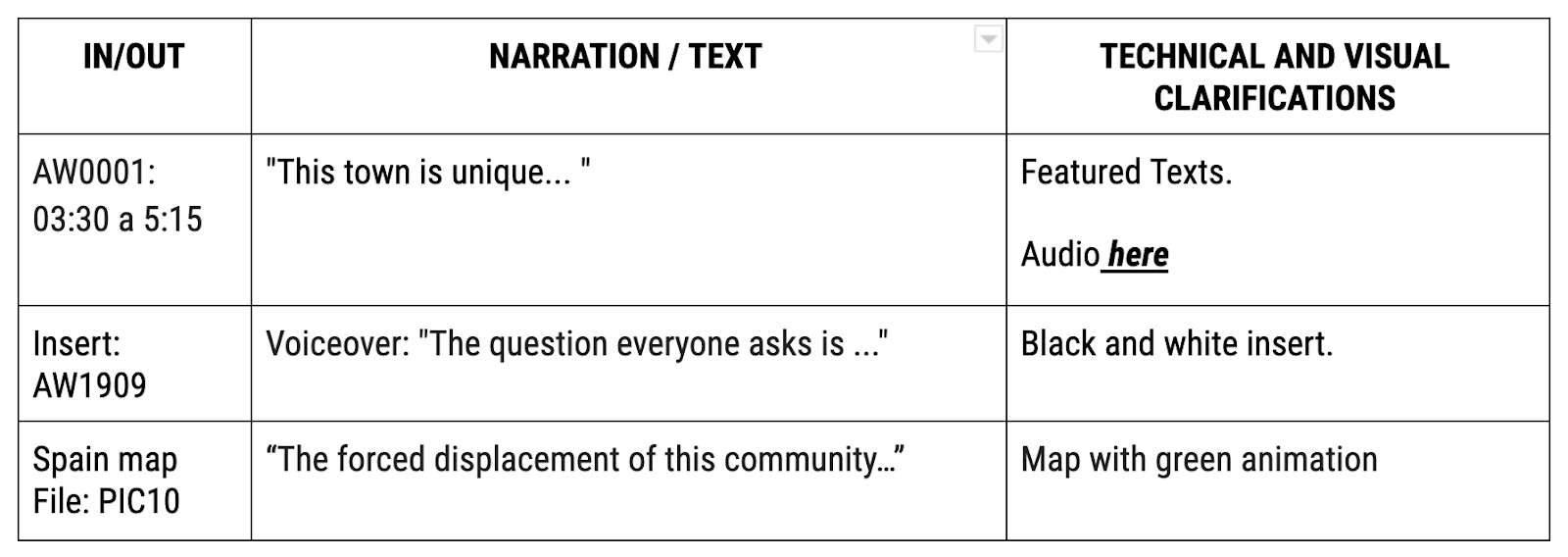This article is fourth in a series from Chicas Poderosas (“Powerful Girls” in English), a global community that promotes female leadership and generates knowledge. Read the first, second and third articles, and follow Chicas Poderosas on Twitter, Instagram and Facebook.
In fiction, they say: “if you can write it, you can shoot it.” However, not every piece of journalism is meant to be told using video. Human, technical and time limitations require journalists and producers to efficiently select the stories they want to tell on-screen, and meticulously design a plan to produce them.
Below we explore the types of stories that resonate well with audiences and important considerations for the planning process. Then readers will learn the basics of turning their ideas into easy-to-follow scripts.
Identifying a story
Types of stories
Stories rich in data and statistics that need to be humanized. Written stories about inflation, unemployment, displacement and similar topics tend to be heavy with figures. In these cases, to increase their impact, analyses and conclusions need to be humanized, and given an emotional element. Video is an ideal mechanism to generate empathy with the stories behind the numbers.
When there’s too much information and you need to synthesize it. Some issues are extremely complex, and the media usually tells these stories in dense articles that ostracize a large portion of the audience. In these cases, video can summarize the main information in a format that most people understand.
When you find an extraordinary character with a strong voice. Unique or extraordinary characters can become lost in the reporter’s voice, so it’s better to let them tell their own story, in their own words.
When a story has audio or visual elements that would be lost when written. This covers a range of stories from natural disasters, protests and more.
Choosing characters
Once you’ve identified the story, you need to decide who will be the main character(s) in the video. Would the story best be told best by a source, reporter or voice-over? Consider who you can quickly get in touch with, also weighing who will be able to deliver the message in a clear and concise manner.
Drawing limits
When journalists begin to do research, stories grow and become more complex. One video can’t tell the whole story of a community wiped out by violence, or the evolution of the feminist movement, for example. Selecting parts of the story and leaving others aside doesn’t make the story weaker — on the contrary, the audience will be able to focus on a single, well-told story, rather than several scattered stories.
The length of the video will also set limits on the story. When deciding on length, consider the platform you plan to publish the video on, as the algorithms of each social network work differently. For example, Facebook prioritizes videos over three minutes, and YouTube prioritizes videos between 15 and 20 minutes. These algorithms change frequently, which is why it’s important to be up to date.
If you have limited time to shoot, ask whether your media outlet is subscribed to an agency or an image bank from which you can pull some B-roll, or background footage, to save time.
Designing a shooting plan
Once you know how long you have to shoot, you need to design a shooting plan that includes time to conduct research, contact sources, choose an angle and gather key characters. Then, you need time to write the script, film and edit. It’s imperative to plan this out before you begin.
Writing an audiovisual script
Script basics
The script should include a general overview of the story, as well as the instructions to tell the story step by step. Describe each scene, including the scene’s audio, video and photo elements.
Each team has to determine the format and the complexity of the script, according to their preferences. Everyone has to know, interpret and use the same structure. A basic script outline might be:

Tips to remember:
- In and out refer to the timestamp that the audiovisual elements will be added.
- Always include the name of the video, photo and audio files that you will use (example: AW1909, PIC10).
- Explain where the inserts, voice over and text should be added.
- Indicate when you want to use techniques like transitions and effects.
- Include design references, as well as any other observations the director and the producer will need.
As a practice exercise, find a video online that mirrors the structure you’d like, and write the script. Write everything that happens, and show it to a friend or colleague to get feedback on whether or not it’s clear.
Hooking the audience
The first five seconds of your video is the hook, which is the part that will make your audience interested in your story and willing to watch to the end — or not.
There is no exact formula for writing a hook. It could be the main character in front of a camera saying a meaningful sentence, a compelling data point or a scene with a lot of audiovisual power.
The key is that the hook introduces the story and generates intrigue in the audience. It should trigger an emotional effect, and should leave the audience asking questions such as, “What will happen to this character?” “How did we arrive to this situation?” “How will it be solved?” and “What can we do to help?”
Building suspense
Don’t rush to respond to every question in the first minute. Define which storytelling strategy works best for you and your team, and build suspense throughout the video, generating different peaks of interest, not just one at the beginning.
At the end of the script, make sure you have fulfilled the promise that you made to your audience and delivered a complete story. Always ask yourself: “Did I achieve my goal with this video?”
Video storytelling — especially on social media — has a lot of freedom. The only thing you need to respect is the hook, then you can move the pieces around as you wish to keep the intrigue and suspense.
Main image CC-licensed by Unsplash via Sam McGhee.

